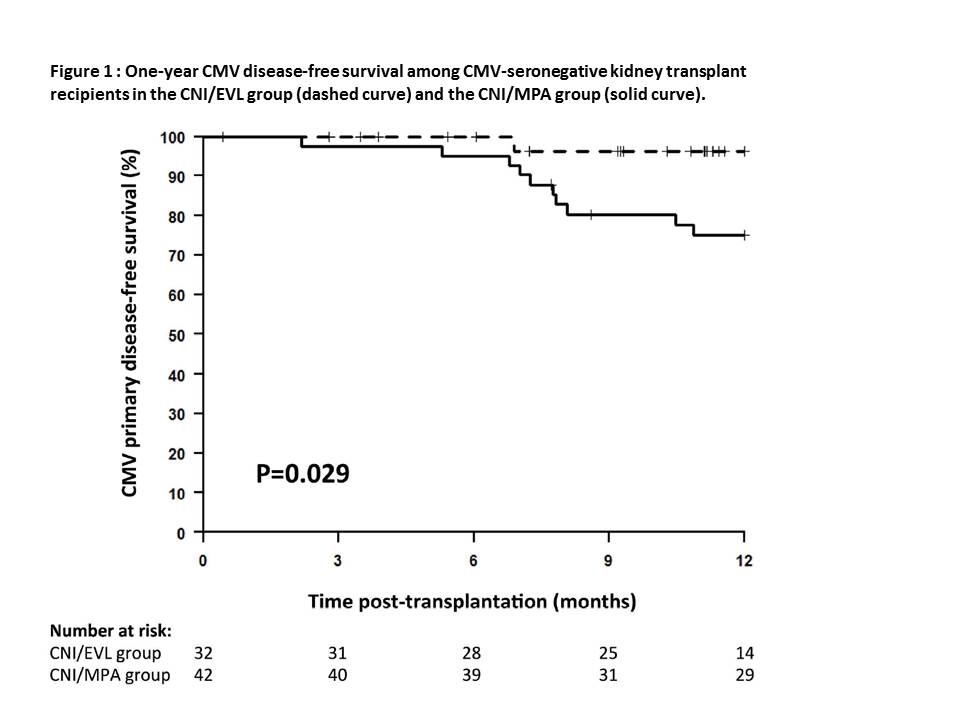De Novo Use of Everolimus Reduces Late-Onset Cytomegalovirus Primary Disease Occurring After Antiviral Prophylaxis Discontinuation in Kidney Transplant Recipients.
1Nephrology Unit, Cliniques Universitaires Saint-Luc, Brussels, Belgium
2Virology Unit, Hôpital Necker-Enfants Malades, AP-HP, Paris, France
3Kidney Transplantation and Intensive Care Unit, Hôpital Necker-Enfants Malades, AP-HP, Paris, France
4Anesthesia Unit, Hôpital Necker-Enfants Malades, AP-HP, Paris, France
5Urology Unit, Hôpital Necker-Enfants Malades, AP-HP, Paris, France
Meeting: 2017 American Transplant Congress
Abstract number: 73
Keywords: Infection
Session Information
Session Name: Concurrent Session: Novel Immunosuppression Regimens - Tacrolimus Combinations
Session Type: Concurrent Session
Date: Sunday, April 30, 2017
Session Time: 2:30pm-4:00pm
 Presentation Time: 3:30pm-3:42pm
Presentation Time: 3:30pm-3:42pm
Location: E450b
Background: Donor (D)+/recipient (R)- serostatus is critically associated with an higher risk of cytomegalovirus (CMV) infection and disease. Antiviral prophylaxis is conventionally used in such patients, but late-onset CMV infection/disease still occurs after prophylaxis discontinuation.
Method: We retrospectively analyzed data of 215 low immunological risk patients who received kidney transplantation in our center between 2011 and 2016.
Results: Ninety-seven patients received a combination of everolimus (EVL)/reduced doses of calcineurin inhibitors (CNI) (EVL group) de novo, and 118 received a combination of mycophenolic acid (MPA)/standard doses of CNI (MPA group) de novo. All patients received induction by basiliximab, steroids and standardized antiviral prophylaxis depending on their CMV D/R serostatus. D+/R- recipients comprised 17% (n=16) of the EVL group and 19% (n=22) of the MPA group (P=0.722). In the D+/R- subgroup, the 1-year incidence of late-onset CMV primary disease after the withdrawal of prophylaxis was lower than that in the EVL group (6% vs 41%, P=0.025). Kaplan-Meier analysis of 1-year CMV primary disease-free survival in seronegative patients showed significantly better survival in the EVL group (P=0.029, log-rank test).  Conclusion: The de novo use of EVL reduces late-onset CMV primary disease after the withdrawal of antiviral prophylaxis in kidney transplantation patients.
Conclusion: The de novo use of EVL reduces late-onset CMV primary disease after the withdrawal of antiviral prophylaxis in kidney transplantation patients.
CITATION INFORMATION: Devresse A, Avettand-Fenoel V, Scemla A, Morin L, Lebreton X, Tinel C, Amrouche L, Lamhaut L, Timsit M.-O, Zuber J, Legendre C, Anglicheau D. De Novo Use of Everolimus Reduces Late-Onset Cytomegalovirus Primary Disease Occurring After Antiviral Prophylaxis Discontinuation in Kidney Transplant Recipients. Am J Transplant. 2017;17 (suppl 3).
To cite this abstract in AMA style:
Devresse A, Avettand-Fenoel V, Scemla A, Morin L, Lebreton X, Tinel C, Amrouche L, Lamhaut L, Timsit M-O, Zuber J, Legendre C, Anglicheau D. De Novo Use of Everolimus Reduces Late-Onset Cytomegalovirus Primary Disease Occurring After Antiviral Prophylaxis Discontinuation in Kidney Transplant Recipients. [abstract]. Am J Transplant. 2017; 17 (suppl 3). https://atcmeetingabstracts.com/abstract/de-novo-use-of-everolimus-reduces-late-onset-cytomegalovirus-primary-disease-occurring-after-antiviral-prophylaxis-discontinuation-in-kidney-transplant-recipients/. Accessed December 15, 2025.« Back to 2017 American Transplant Congress
